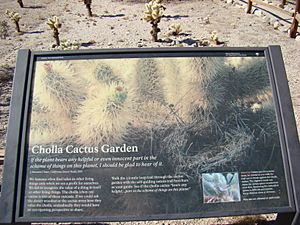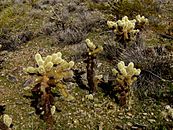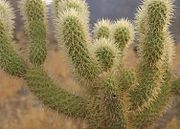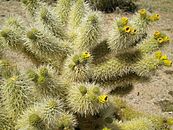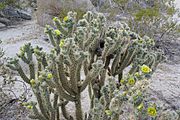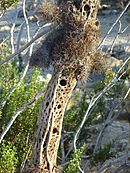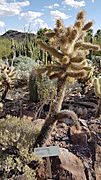Teddy bear cholla facts for kids
Quick facts for kids Teddy bear cholla |
|
|---|---|
 |
|
| Scientific classification | |
| Genus: |
Cylindropuntia
|
| Species: |
bigelovii
|
| Synonyms | |
|
Opuntia bigelovii |
|
The teddy bear cholla (pronounced choy-ya) is a type of cactus found in the deserts of the United States (in California, Arizona, and Nevada) and northwestern Mexico. Its scientific name is Cylindropuntia bigelovii. Even though it's called "teddy bear," this cactus is anything but soft and cuddly!
Contents
Meet the Teddy Bear Cholla
The teddy bear cholla looks soft because it's covered in a thick layer of very sharp spines. These spines completely hide the stems, which is why it got its funny nickname. But don't let the name fool you – those spines are a strong defense!
This cactus can grow from about 1 to 5 feet (0.3 to 1.5 meters) tall. It has a clear trunk, and its branches grow out near the top, almost straight across. Older branches often fall off, and the trunk gets darker as the plant ages.
The spines are silvery-white and look fuzzy, but they are very tough. They are about 1 inch (2.5 cm) long and have a papery cover that can come off. These spines are actually a special kind of leaf.
Flowers and Reproduction
In May and June, yellow-green flowers bloom at the tips of the stems. These flowers are usually about 1.4 inches (3.6 cm) long. They produce fruit that is about 0.7 inches (1.9 cm) wide. The fruit can be bumpy and sometimes has spines.
The fruit usually has very few seeds that can grow. Instead, the teddy bear cholla mostly reproduces in a different way. Its stems break off easily and can stick to animals. These stems are often carried far away by sticking to fur or skin. They are very painful to remove! If a piece of this cholla sticks to you, a good way to get it off is with a hair comb. The spines have tiny barbs that hold on very tightly.
Because of this, you often see small groups of these chollas growing together. Many of them are actually clones, meaning they are exact copies of the same original plant.
Just like its relative, the jumping cholla, the stems of the teddy bear cholla detach easily. The ground around a grown plant is often covered with these fallen "cholla balls." New plants can start growing wherever these balls land and take root.
Cholla's Desert Neighbors
The teddy bear cholla plays an important role in the desert ecosystem.
Wildlife and Shelter
Desert pack rats, like the desert woodrat, collect these spiky cholla balls. They pile them around their burrows to create a strong defense. This helps protect them from predators like kit foxes and coyotes. However, several types of snakes eat these rats, which helps keep the rat population balanced.
The cactus wren is a bird often seen sitting on the cholla and other cacti. These birds also use different cacti, including the teddy bear cholla, to build their nests. The spines help protect their eggs and young from predators.
Where Does It Grow?
The teddy bear cholla grows in desert areas up to about 3,000 feet (900 meters) high. You can find it in the "Low Desert" or Colorado Desert of Southern California. It also grows in other parts of the Sonoran Desert in the Southwestern United States and northwestern Mexico.
In the Lower Colorado River Valley, the densest groups of teddy bear chollas are found in higher, rockier places. Fewer other desert plants grow there, but two common ones are the ocotillo and the saguaro cactus.
You can also see the teddy bear cholla in a special area called the Cholla Cactus Garden. This garden is part of the Joshua Tree National Park. Other desert plants found there include the desert senna, pencil cholla, creosote bush, jojoba, and climbing milkweed. The climbing milkweed can sometimes grow over and even harm the teddy bear cholla.
Gallery
-
Blooming Cylindropuntia bigelovii with bird nest, in Anza Borrego Desert State Park
See also
 In Spanish: Cylindropuntia bigelovii para niños
In Spanish: Cylindropuntia bigelovii para niños


